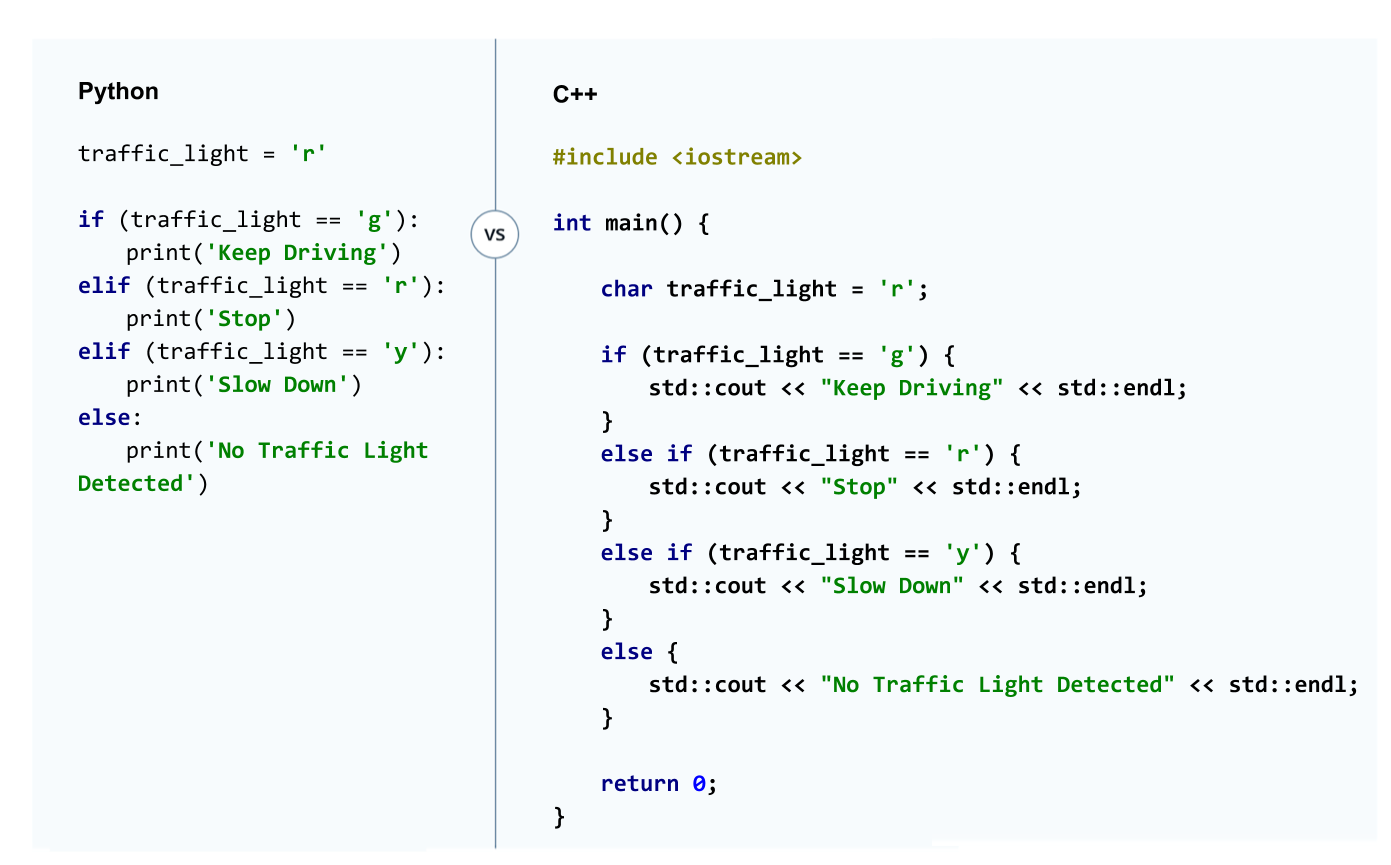18. If 和布尔逻辑
控制语句
现在,你已经知道如何声明变量和编写函数了,你在 C++ 语言学习方面已经取得了良好进展。
到目前为止,你接触的程序相对都比较简单。你需要控制语句,才能编写更复杂的程序。像 if 和 for 之类的控制语句是许多编程语言的基础。它们允许你确定运行代码语句的时间和频率。
在本节中,你将学习使用 C++ 的 if 语句和相关的布尔逻辑使用。
下一节将介绍
while
和
for
循环。最后,我们会讲解** switch **语句。Python 有和 *
if
、
while
* 和
for
等价的语句,但没有
switch
语句。
学习控制语句之后,你可以编写更复杂的 C++ 程序。
Python vs. C++ If
下面是一组 Python 中 if 语句与 C++ 中等价语句的示例。
你会看到逻辑结构完全相同,但语法略有不同。你可以把下面的代码看作交通灯分类程序的一部分,它会告诉车辆当前
交通信号的颜色。

C++ 中的通用 if 语句如下所示:
if (<some criteria>) {
statement_1;
statement_2;
.... etc
}
else if (<some other criteria>) {
statement_1;
statement_2;
.... etc
}
else (<some other criteria>) {
statement_1;
statement_2;
.... etc
}布尔逻辑
要让 if 语句生效,你需要布尔逻辑。布尔逻辑在 Python 和 C++ 中的实现方式相同;有些语法是完全相同的,有些稍有不同。
下面是一个表格,显示了两种语言的比较运算符:
| 运算符 | Python | C++ |
|---|---|---|
| 等于 | == | == |
| 不等于 | != | != |
| 大于 | > | > |
| 小于 | < | < |
| 大于等于 | >= | >= |
| 小于等于 | <= | <= |
是的,两种语言中的比较运算符的确完全一样!
那么,逻辑运算符 and 、 or 以及 not 呢?
它们在两种语言中不同:
| 运算符 | Python | C++ |
|---|---|---|
| and | and | && |
| or | or | || |
| not | not | ! |
C++ 中的 or 运算符由两个竖线字符表示。在英文键盘上,您可以在回车键上方找到竖线键。
小测试
运算符
QUIZ QUESTION: :
将定义与 C++ 运算符匹配
ANSWER CHOICES:
|
Definition |
C++ 中的运算符 |
|---|---|
|
not |
|
|
{} |
|
|
<= |
|
|
?? |
|
|
% |
|
|
or |
|
|
== |
|
|
< |
|
|
|| |
|
|
and |
|
|
! |
|
|
|
|
|
&& |
SOLUTION:
|
Definition |
C++ 中的运算符 |
|---|---|
|
<= |
|
|
== |
|
|
< |
|
|
|| |
|
|
! |
|
|
|
|
|
&& |
游乐场
这里是游乐场,你可以编写自己的 if 语句。在代码注释中,你会看到几条关于代码编写的建议。solution.cpp 文件中提供了参考答案,可以和你自己的代码对比学习。
Start Quiz: